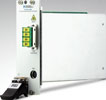

National Instruments has announced the NI PXIe-4844 optical sensor interrogator, a two-slot 3U PXI Express module for fibre Bragg grating (FBG) sensors. FBG sensors operate by reflecting a wavelength of light that corresponds to changes in physical phenomena such as strain and temperature. Unlike conventional electrical sensors, FBG sensors are nonconductive, electrically passive and immune to electromagnetic interference, making them a safe and reliable alternative in environments subject to noise, corrosion or extreme weather. The transmission medium is standard optical fibre instead of
copper wire, making it possible to take measurements over long distances of up to 10 km. Engineers and scientists can use FBG sensors for the most common measurement types, including strain, temperature and pressure, and several sensors can be daisy chained along a single optical fibre to reduce the size, weight and complexity of the measurement system.
The NI PXIe-4844 optical sensor interrogator is the latest addition to the NI SC Express family of sensor measurement modules for PXI Express. It features four optical channels that are simultaneously scanned at 10 Hz. Each channel has an 80 nm wavelength range (1510 to 1590 nm), which can scan 20 or more FBG sensors per channel (more than 80 FBG sensors per module, depending on the sensor range). For high-channel-count applications, engineers and scientists can further extend the maximum number of FBG sensors per module by connecting one or more optical channels to an external optical multiplexer or by adding more NI PXIe-4844 modules in the same PXI chassis.
In addition to multiple channels, the NI PXIe-4844 features an optical core that combines a high-power, low-noise swept wavelength laser with fibre Fabry-Perot tuneable filter technology from Micron Optics. The module delivers a wavelength accuracy, repeatability and stability of 1 pm, which is equivalent to sensor accuracies of approximately 1,2 microstrain and 0,1°C for FBG strain and temperature sensors, respectively. Unlike most instruments, the interrogator does not require periodic external calibration as every scan made by the NI PXIe-4844 is calibrated to an onboard NIST-traceable wavelength reference.
Engineers and scientists can program the NI PXIe-4844 with easy-to-use configuration and driver software to shorten setup and configuration time. The module includes the NI-OSI Explorer utility for automatic sensor detection and simplified sensor configuration as well as the NI-OSI driver software with easy-to-use LabVIEW API for acquiring measurements in scaled physical units. Using NI LabVIEW software, engineers and scientists can view, log and analyse the sensor data. Applications in LabVIEW can easily be extended to also include synchronisation with other sensor types, instruments or control systems using intuitive graphical icons and wires that resemble a flowchart. LabVIEW also offers integration with thousands of hardware devices and provides hundreds of built-in libraries for advanced analysis and data visualisation.
The industry-standard PXI platform for measurement and automation provides the industry’s highest-performance timing and synchronisation capabilities and the high-throughput PCI Express bus. The NI PXIe-4844 can be integrated into the same chassis as other PXI modules including SC Express for complementary electrical data acquisition and control. With the PXI platform, engineers and scientists can simplify complex measurement systems located in remote, challenging environments by combining both optical and electrical measurements into the same PXI chassis.
Applications that can benefit from the NI PXIe-4844 include civionics, for distributed measurements over long distances including bridges, dams, tunnels and other civil structures; energy, for monitoring wind turbine blades, pipelines, nuclear reactors, offshore platforms and power generators; and transportation, for testing and monitoring marine vessels, rail vehicles and aircraft components.

© Technews Publishing (Pty) Ltd | All Rights Reserved